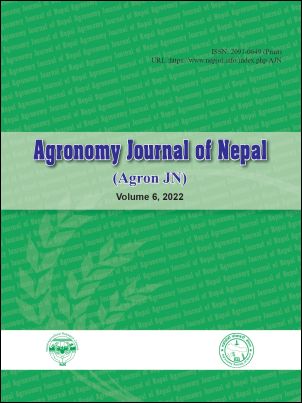Crop Establishment Methods, Varieties and Levels of Zinc on Growth and Yield of Rice in Chitwan, Nepal
DOI:
https://doi.org/10.3126/ajn.v6i1.47925Keywords:
Direct seeded rice, Transplanted rice, Zinc, Grain yieldAbstract
With the aim of identifying the appropriate doses of Zinc in rice for different varieties under various establishment methods, an experiment was carried out in a strip-split plot design with three replications at Agriculture and Forestry University, Rampur, Chitwan during 2015-16. The treatment consists of two crop establishment methods (Transplanted rice (TPR) and Direct Seeded Rice (DSR)) in the vertical strip and two varieties (Hybrid Gorakhnath-509 and Sabitri) in the horizontal strip and four levels of ZnSO4 (0, 15, 30 and 45 kg ha-1) in sub-sub plot. The observations were recorded on growth, yield attributes, grain yield and economics. The research results revealed that the application of ZnSO4 @ 15 Kg ha-1 significantly increased the grain yield of DSR as compared to the non-application of ZnSO4. The higher grain yield of rice was because of increased yield attributes like effective tillers, thousand-grain weight and the number of filled grains per panicle. Crop establishment methods and varieties did not have a significant influence on the grain yield of rice. DSR had a lower cost of cultivation, higher net return and higher benefit-cost ratio as compared to TPR. The variety Sabitri had lower cost of cultivation, higher net return and higher benefit-cost ratio as compared to Gorakhnath-509. Similarly, the application of ZnSO4 @ of 15 Kg ha-1 produced the highest net return and the highest benefit-cost ratio. Therefore, ZnSO4 @ 15 kg ha-1 could be an option for increased yield and net return for DSR in Chitwan.
Downloads
Downloads
Published
How to Cite
Issue
Section
License
Copyright (c) 2022 Agronomy Society of Nepal (ASoN)

This work is licensed under a Creative Commons Attribution-NonCommercial 4.0 International License.
ASON permits for free use, distribution and reproduction in any medium if the original work is properly cited and not used for commercial purposes.




